tire pressure MERCEDES-BENZ S CLASS 2018 Owners Manual
[x] Cancel search | Manufacturer: MERCEDES-BENZ, Model Year: 2018, Model line: S CLASS, Model: MERCEDES-BENZ S CLASS 2018Pages: 562, PDF Size: 7.25 MB
Page 5 of 562
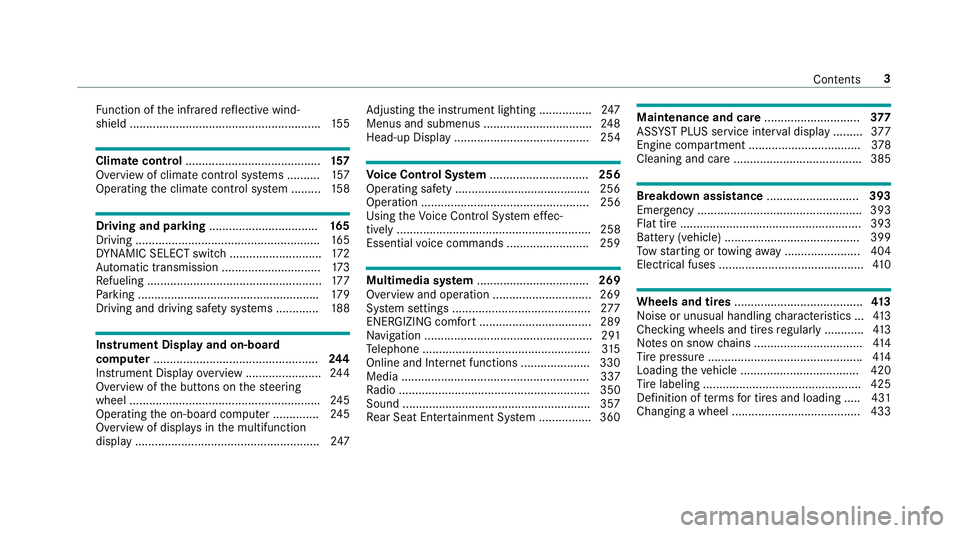
Fu nction of th e infra re d re fl ective wind‐
shield ......................................................... .1 55
Climate control ......................................... 15 7
Overview of climate cont ro l sy st ems ......... .1 57
Operating th e climate control sy st em ......... 15 8
Drivin g and pa rk ing ................................. 16 5
Driving ........................................................ 16 5
DY NA MIC SELECT switch ........................... .1 72
Au to matic transmission .............................. 17 3
Re fueling ..................................................... 17 7
Pa rk ing ...................................................... .1 79
Driving and driving saf et y sy st ems ............ .1 88
Instrument Display and on-board
co mp uter .................................................. 24 4
Instrument Display ove rv iew ...................... .2 44
Overview of th e buttons on th e st eering
wheel ......................................................... .2 45
Operating th e on-board computer .............. 24 5
Overview of displa ys in th e multifunction
display ........................................................ 24 7 Ad justing th e instrument lighting ............... .2 47
Menus and submenus ................................. 24 8
Head-up Display ......................................... 254
Vo ice Control Sy st em .............................. 256
Operating saf et y ........................................ .2 56
Operation ................................................... 256
Using th e Vo ice Cont ro l Sy st em ef fe c‐
tively ........................................................... 258
Essential vo ice commands ........................ .2 59
Multimedia sy st em .................................. 269
Overview and operation .............................. 269
Sy st em settings .......................................... 27 7
ENERGIZING comfort .................................. 289
Na vigation ................................................... 291
Te lephone .................................................. .3 15
Online and Internet functions ..................... 330
Media ......................................................... 337
Ra dio .......................................................... 350
Sound ........................................................ .3 57
Re ar Seat En te rt ainment Sy st em ............... .3 60 Maintenance and care ............................. 37 7
ASS YS T PLUS service inter va l display ........ .3 77
Engine compartment .................................. 37 8
Cleaning and care ...................................... .3 85
Breakdown assi st ance ............................ 393
Emergency ................................................. .3 93
Flat tire ....................................................... 393
Battery (vehicle) ......................................... 399
To w st arting or to wing aw ay ....................... 404
Electrical fuses ............................................ 41 0
Wheels and tires ....................................... 41 3
Noise or unusual handling ch aracteristics .. .4 13
Checking wheels and tires re gularly ............ 41 3
No te s on snow ch ains ................................ .4 14
Ti re pressure .............................................. .4 14
Loading th e ve hicle .................................... 420
Ti re labeling ................................................ 425
Definition of te rm s fo r tires and loading ..... 431
Changing a wheel ....................................... 433 Contents 3
Page 191 of 562
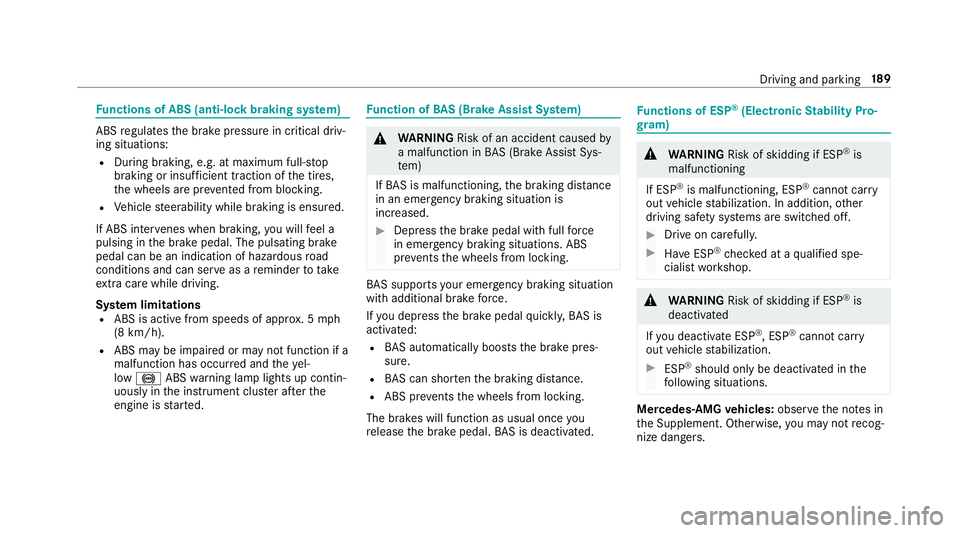
Fu nctions of ABS (anti-lock braking sy st em)
ABS re gulates th e brake pressure in critical driv‐
ing situations: R
During braking, e.g. at maximum full-s to p
braking or insuf fi cient traction of th e tires,
th e wheels are pr ev ented from blocking.R
Ve hicle st eerability while braking is ensured.
If ABS inter ve nes when braking, yo u will fe el a
pulsing in th e brake pedal. The pulsating brake
pedal can be an indication of hazardous ro ad
conditions and can ser ve as a re minder to ta ke
ex tra care while driving.
Sy st em limitations R
ABS is active from speeds of appr ox . 5 mp h
(8 km/h). R
ABS may be impaired or may not function if a
malfunction has occur re d and th e ye l‐
low �% ABS wa rn ing lamp lights up contin‐
uously in th e instrument clus te r af te r th e
engine is st ar te d. Fu nction of BA S (Brake Assist Sy st em)
�q
WA RNING Risk of an accident caused by
a malfunction in BA S (Brake Assi st Sys‐
te m)
If BA S is malfunctioning, th e braking dis ta nce
in an emergency braking situation is
increased. �
Page 198 of 562
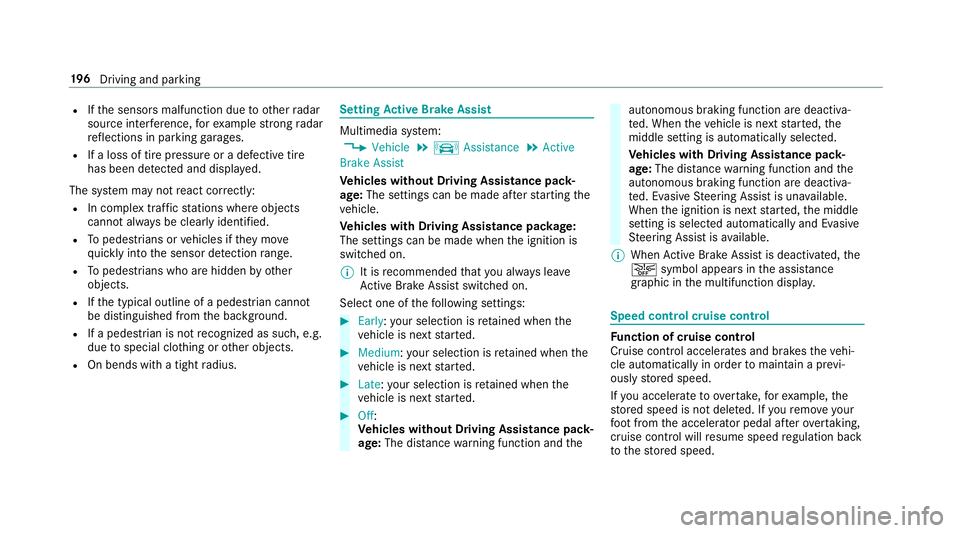
R
If th e sensors malfunction due to ot her ra dar
source inter fe re nce, fo r ex ample stro ng ra dar
re fl ections in parking ga ra ge s.R
If a loss of tire pressure or a defective tire
has been de te cted and displ ay ed.
The sy st em may not re act cor re ctly:R
In compl ex traf fi c st ations where objects
cannot alw ay s be clearly identified.R
To pedestrians or ve hicles if th ey mo ve
qu ickly into th e sensor de te ction ra nge.R
To pedestrians who are hidden by ot her
objects. R
If th e typical outline of a pedestrian cann ot
be distinguished from th e bac kg ro und.R
If a pedestrian is not re cognized as su ch , e.g.
due to special clo th ing or ot her objects.R
On bends with a tight ra dius. Setting Ac tive Brake Assi st
Multimedia sy st em: �
Page 242 of 562
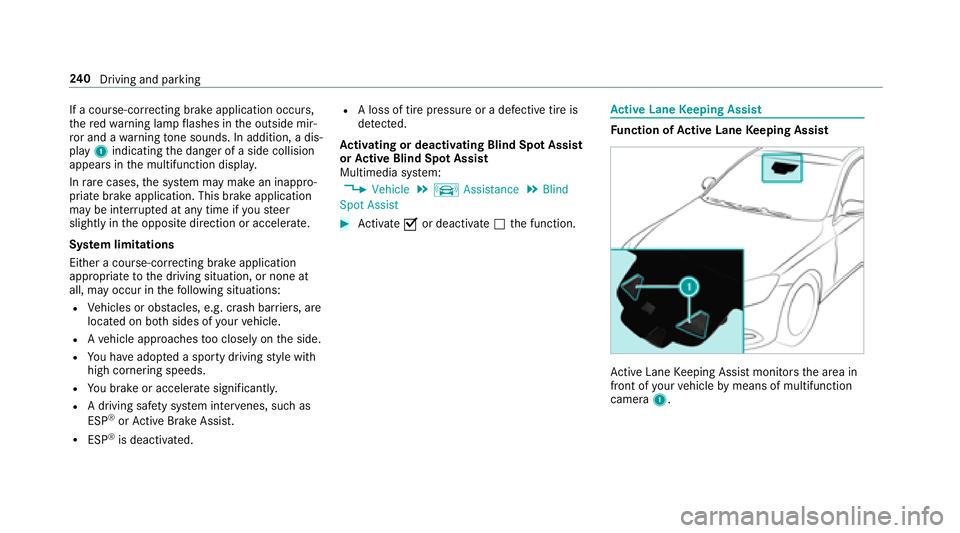
If a course-cor re cting brake application occu rs ,
th e re d wa rn ing lamp fl ashes in th e outside mir‐
ro r and a wa rn ing to ne sounds. In addition, a dis‐
pl ay 1 indicating th e danger of a side collision
appears in th e multifunction displa y.
In ra re cases, th e sy st em may make an inappro‐
priate brake application. This brake application
may be inter ru pte d at any time if yo u st eer
slightly in th e opposite direction or accelera te .
Sy st em limitations
Either a course-cor re cting brake application
appropria te to th e driving situation, or none at
all, may occur in th e fo llowing situations:R
Ve hicles or obs ta cles, e.g. crash ba rr iers, are
located on bo th sides of yo ur ve hicle.R
A ve hicle approaches to o closely on th e side.R
Yo u ha ve adop te d a sporty driving st yl e with
high cornering speeds. R
Yo u br ake or accelerate sign if icantl y.R
A driving sa fe ty sy st em inter ve nes, su ch as
ESP ®
or Ac tive Brake Assi st .R
ESP ®
is deacti va te d. R
A loss of tire pressure or a defective tire is
de te cted.
Ac tivating or deactivating Blind Spot Assi st
or Ac tive Blind Spot Assi st
Multimedia sy st em: �
Page 243 of 562
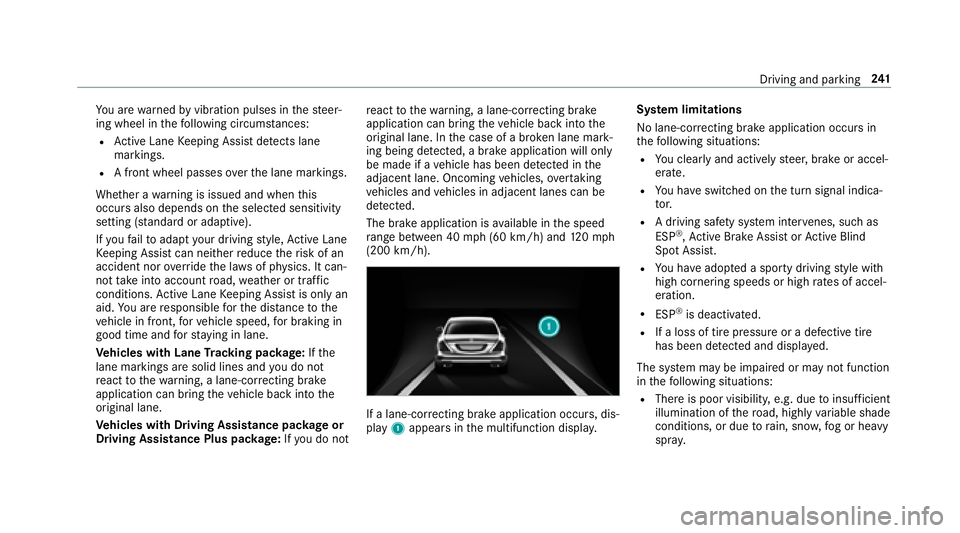
Yo u are wa rn ed by vibration pulses in th e st eer‐
ing wheel in th e fo llowing circums ta nces:R
Ac tive Lane Ke eping Assist de te cts lane
markings. R
A front wheel passes ov er th e lane markings.
Whe th er a wa rn ing is issued and when th is
occurs also depends on th e selected sensitivity
setting (s ta nda rd or adaptive).
If yo u fa il to adapt yo ur drivin g st yl e, Ac tive Lane
Ke eping Assist can neither re duce th e ri sk of an
accident nor ove rr ide th e la ws of ph ys ics. It can‐
not ta ke into account ro ad, we ather or traf fi c
conditions. Ac tive Lane Ke eping Assist is only an
aid. Yo u are re sponsible fo r th e dis ta nce to th e
ve hicle in front, fo r ve hicle speed, fo r braking in
good time and fo r st ay ing in lane.
Ve hicles with Lane Tr acking pac ka ge : If th e
lane markings are solid lines and yo u do not
re act to th e wa rn ing, a lane-cor re cting brake
application can bring th e ve hicle back into th e
original lane.
Ve hicles with Driving Assistance pac ka ge or
Driving Assistance Plus pa ck age: If yo u do not re act to th e wa rn ing, a lane-cor re cting brake
application can bring th e ve hicle back into th e
original lane. In th e case of a broken lane mark‐
ing being de te cted, a brake application will only
be made if a ve hicle has been de te cte d in th e
adj
acent lane. Oncoming ve hicles, ove rt aking
ve hicles and ve hicles in adjacent lanes can be
de te cted.
The brake application is av ailable in th e speed
ra nge between 40 mp h (60 km/h) and 12 0 mp h
(200 km/h).
If a lane-cor re cting brake application occu rs , dis‐
play 1 appears in th e multifunction displa y. Sy st em limitations
No lane-cor re cting brake application occu rs in
th e fo llowing situations: R
Yo u clear ly and actively st eer, brake or accel‐
erate. R
Yo u ha ve switched on th e turn signal indica‐
to r. R
A driving sa fe ty sy st em inter ve nes, su ch as
ESP ®
, Ac tive Brake Assi st or Ac tive Blind
Spot Assi st . R
Yo u ha ve adop te d a sporty driving st yl e with
high cornering speeds or high ra te s of accel‐
eration. R
ESP ®
is deactivated. R
If a loss of tire pressure or a defective tire
has been de te cted and displ ay ed.
The sy st em may be impaired or may not function
in th e fo llowing situations: R
There is poor visibilit y, e.g. due to insuf fi cient
illumination of th e ro ad, high ly va ri able shade
conditions, or due to ra in, sno w, fo g or heavy
spr ay . Driving and pa rk ing 24 1
Page 397 of 562
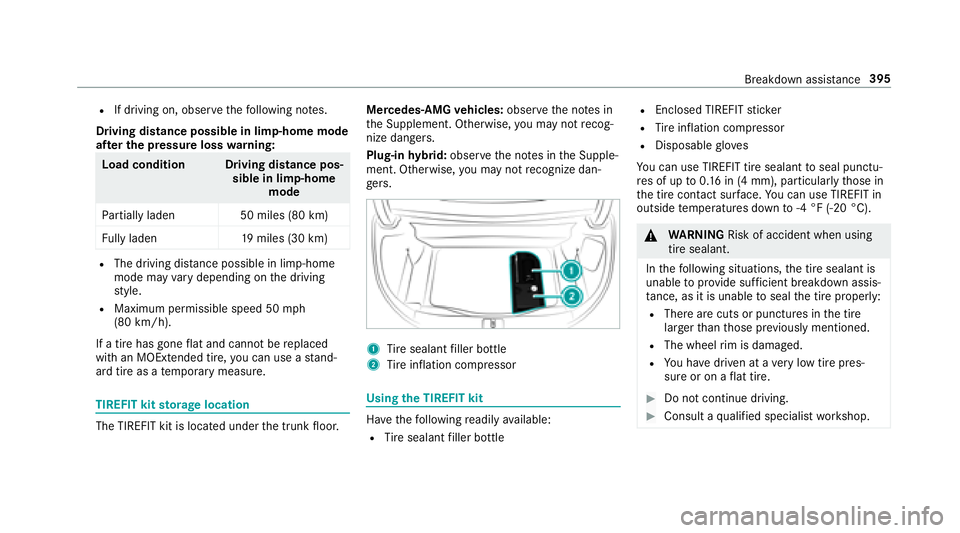
R
If driving on, obser ve th e fo llowing no te s.
Driving distance possible in limp-home mode
af te r the pressure loss wa rn ing:
Load condition Driving distance pos‐
sible in limp-home
mode
Pa rt ially laden 50 miles (80 km)
Fu lly laden 19 miles (30 km)R
The driving dis ta nce possible in li mp -home
mode may va ry depending on th e driving
st yl e.R
Maximum permissible speed 50 mp h
(80 km/h).
If a tire has gone fl at and cannot be re placed
with an MOEx te nded tire, yo u can use a st and‐
ard tire as a te mp orary measure.
TIREFIT kit st orage location
The TIREFIT kit is located under th e trunk fl oor. Mercedes‑AMG ve hicles: obse rv e th e no te s in
th e Supplement. Otherwise, yo u may not re cog‐
nize dangers.
Plug-in hy brid: obser ve th e no te s in th e Supple‐
ment. Otherwise, yo u may not re cognize dan‐
ge rs .
1
Ti re sealant fi ller bottle
2
Ti re inflation compressor
Using th e TIREFIT kit
Ha ve th e fo llowing re adily av ailable:R
Ti re sealant fi ller bottle R
Enclosed TIREFIT st ic ke r R
Ti re inflation compressor R
Disposable gl ov es
Yo u can use TIREFIT tire sealant to seal punctu‐
re s of up to 0. 16 in (4 mm), particular ly th ose in
th e tire con ta ct su rf ace. Yo u can use TIREFIT in
outside te mp eratures down to -4 °F (-20 °C).
�q
WA RNING Risk of accident when using
tire sealant.
In th e fo llowing situations, th e tire sealant is
unable to pr ov ide suf fi cient breakdown assis‐
ta nce, as it is unable to seal th e tire proper ly :R
There are cuts or punctures in th e tire
lar ge r th an th ose pr ev iously mentioned. R
The wheel ri m is dama ge d. R
Yo u ha ve driven at a ve ry low tire pres‐
sure or on a fl at tire. �
Page 415 of 562
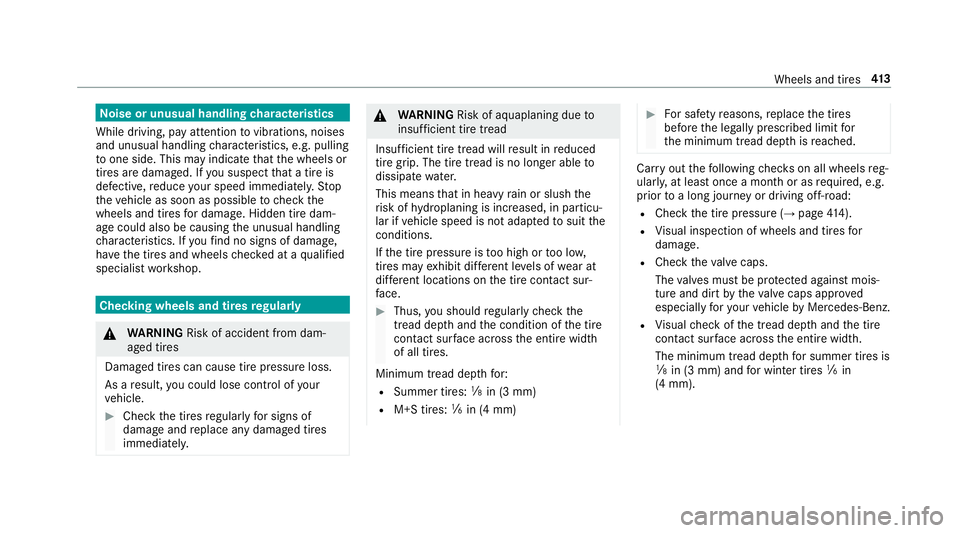
No ise or unusual handling ch aracteristics
While driving, pay attention to vibrations, noises
and unusual handling ch aracteristics, e.g. pulling
to one side. This may indicate th at th e wheels or
tires are damaged. If yo u suspect th at a tire is
defective, re duce yo ur speed immediatel y. St op
th e ve hicle as soon as possible to ch eck th e
wheels and tires fo r dama ge . Hidden tire dam‐
age could also be causing th e unusual handling
ch aracteristics. If yo u fi nd no signs of damage,
ha ve th e tires and wheels ch ec ke d at a qu alified
specialist wo rk shop.
Checking wheels and tires re gular ly
�q
WA RNING Risk of accident from dam‐
aged tires
Dama ge d tires can cause tire pressure loss.
As a re sult, yo u could lose cont ro l of yo ur
ve hicle. �
Page 418 of 562

�q
WA RNING Risk of accident caused by
re peated drop in tire pressure
If th e tire pressure drops re peatedl y, th e
wheel, va lv e or tire may be damaged.
Insuf fi cient tire pressure can cause th e tires
to bur st .�
Page 419 of 562
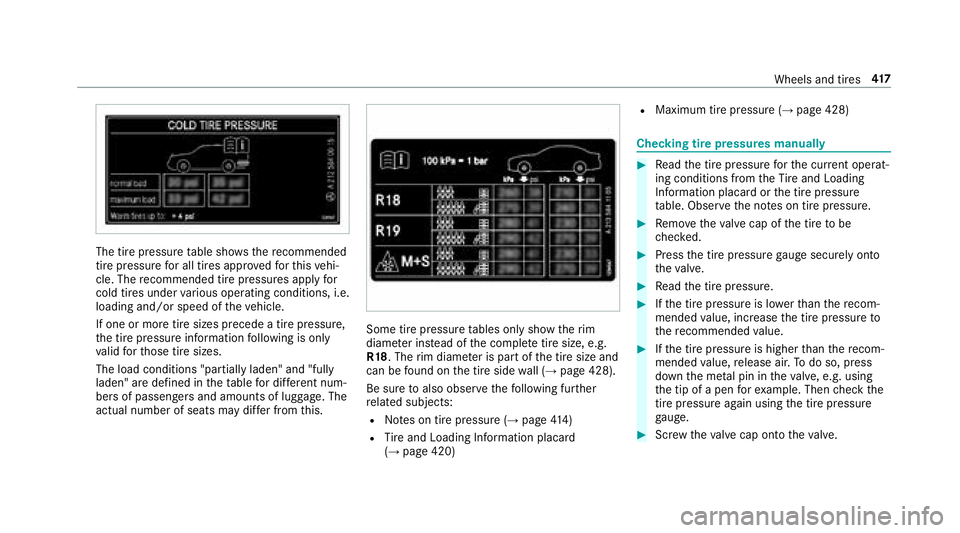
The tire pressure ta ble sho ws th e re commended
tire pressure fo r all tires app ro ve d fo r th is ve hi‐
cle. The re commended tire pressures apply fo r
cold tires under va ri ous operating conditions, i.e.
loading and/or speed of th e ve hicle.
If one or more tire sizes precede a tire pressure,
th e tire pressure information fo llowing is only
va lid fo r th ose tire sizes.
The load conditions "partially laden" and "fully
laden" are defined in th e ta ble fo r dif fe re nt num‐
be rs of passengers and amounts of luggage. The
actual number of seats may dif fe r from th is. Some tire pressure ta bles only show th e ri m
diame te r ins te ad of th e comple te tire size, e.g.
R18 . The ri m diame te r is part of th e tire size and
can be fo und on th e tire side wa ll ( →
page 428).
Be sure to also obse rv e th e fo llowing fur th er
re lated subjects: R
No te s on tire pressure ( →
page 41 4)R
Ti re and Loading In fo rm ation placard
( →
page 420) R
Maximum tire pressure ( →
page 428)
Checking tire pressu re s manually �
Page 420 of 562
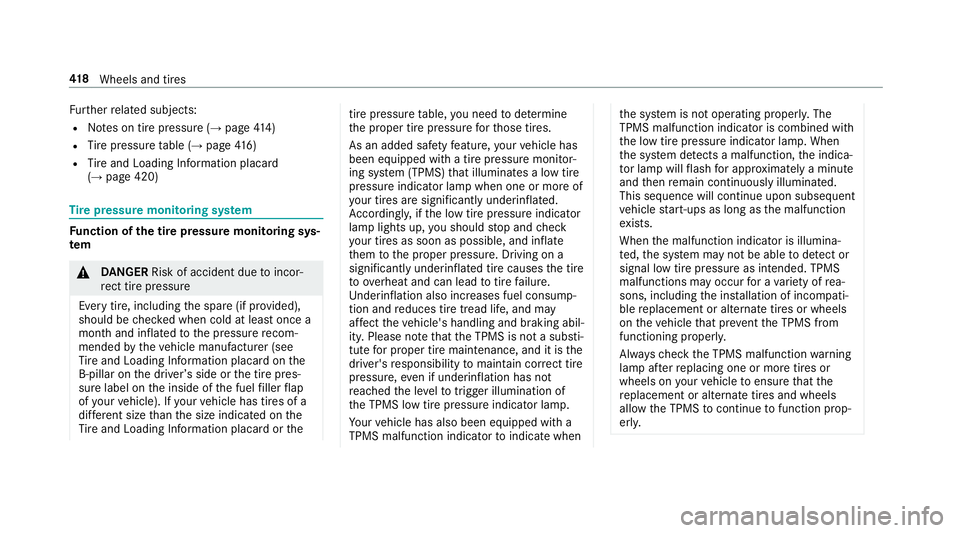
Fu rt her re lated subjects:R
No te s on tire pressure ( →
page 41 4)R
Ti re pressure ta ble ( →
page 41 6)R
Ti re and Loading In fo rm ation placard
( →
page 420)
Ti re pressure moni to ri ng sy st em
Fu nction of th e tire pressure moni to ri ng sys‐
te m
�q
DA NG ER Risk of accident due to incor‐
re ct tire pressure
Every tire, including th e spare (if pr ov ided),
should be ch ec ke d when cold at least once a
month and inflated to th e pressure re com‐
mended by th e ve hicle manufacturer (see
Ti re and Loading In fo rm ation placard on th e
B-pillar on th e driver ’s side or th e tire pres‐
sure label on th e inside of th e fuel fi ller fl ap
of yo ur ve hicle). If yo ur ve hicle has tires of a
dif fe re nt size th an th e size indicated on th e
Ti re and Loading In fo rm ation placard or th e tire pressu re ta ble, yo u need to de te rm ine
th e proper tire pressure fo r th ose tires.
As an added saf et y fe ature, yo ur ve hicle has
been equipped with a tire pressure monitor‐
ing sy st em (TPMS) th at illuminates a low tire
pressure indicator lamp when one or more of
yo ur tires are sign if icantly underinflated.
Ac cording ly , if th e low tire pressure indicator
lamp lights up, yo u should st op and ch eck
yo ur tires as soon as possible, and inflate
th em to th e proper pressure. Driving on a
significant ly underinflated tire causes th e tire
to ove rh eat and can lead to tire fa ilure.
Und erinflation also increases fuel consump‐
tion and re duces tire tread life, and may
af fe ct th e ve hicle's handling and braking abil‐
ity. Please no te th at th e TPMS is not a substi‐
tute fo r proper tire maintenance, and it is th e
driver's re sponsibility to maintain cor re ct tire
pressure, ev en if underinflation has not
re ached th e le ve l to trig ge r illumination of
th e TPMS low tire pressure indicator lamp.
Yo ur ve hicle has also been equipped with a
TPMS malfunction indicator to indicate when th e sy st em is not operating properly. The
TPMS malfunction indicator is combined with
th e low tire pressure indicator lamp. When
th e sy st em de te cts a malfunction, th e indica‐
to r lamp will fl ash fo r app ro xima te ly a minute
and th en re main continuously illumina te d.
This sequence will continue upon subsequent
ve hicle st art-ups as long as th e malfunction
ex ists.
When th e malfunction indicator is illumina‐
te d, th e sy st em may not be able to de te ct or
signal low tire pressure as intended. TPMS
malfunctions may occur fo r a va ri et y of re a‐
sons, including th e ins ta llation of incompati‐
ble re placement or alternate tires or wheels
on th e ve hicle th at pr ev ent th e TPMS from
functioning proper ly .
Alw ay s ch eck th e TPMS malfunction wa rn ing
lamp af te r re placing one or more tires or
wheels on yo ur ve hicle to ensure th at th e
re placement or alternate tires and wheels
allow th e TPMS to continue to function prop‐
er ly .41 8
Wheels and tires